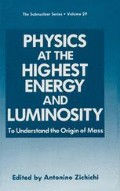Abstract
Not only does the heterotic string admit a heterotic fivebrane as a soliton but the heterotic fivebrane admits as a soliton a heterotic string. This provides further evidence that the two theories may be dual descriptions of the same physics, with the strong coupling regime of one theory described by the weak coupling regime of the other. To illustrate this, we show how the energy-momentum tensor of the quadratic Yang-Mills action associated with the string reduces to that of an elementary fivebrane, and how the energy-momentum tensor of the quartic Yang-Mills action associated with the fivebrane reduces to that of an elementary string.
Work supported in part by NSF grant PHY-9045132
Access this chapter
Tax calculation will be finalised at checkout
Purchases are for personal use only
Preview
Unable to display preview. Download preview PDF.
References
D. J. Gross, J. A. Harvey, E. Martinec and R. Rohm, Nucl. Phys. B256, 253 (1985).
M. J. Duff, E. Sezgin and C. N. Pope, Supermembranes and Physics in 2+1 Dimensions (World Scientific, 1990).
The existence of a heterotic fivebrane was conjectured on the basis of the dual formulations of D = 10 Supergravity in M. J. Duff, Class. Quantum Grav. 5, 189 (1988) and M. J. Duff in The Superworld II, edited by A. Zichichi (Plenum, New York, 1990).
A. Strominger, Nucl. Phys. B343, 167 (1990).
M. J. Duff and J. X. Lu, Phys. Rev. Lett. 66, 1402 (1991).
M. J. Duff and J. X. Lu, Nucl. Phys. B354, (1991) 129.
M. J. Duff and J. X. Lu, Nucl. Phys. B354, (1991) 141.
R. I. Nepomechie, Phys. Rev. D31 (1984) 1921; C. Teitelboim, Phys. Lett. B167, (1986) 69.
A. Dabholkar, G. W. Gibbons, J. A. Harvey, and F. Ruiz-Ruiz, Nucl. Phys. B340, 33 (1990).
A. A. Belavin, A. M. Polyakov, A. S. Schwartz and Yu. S. Tyupkin, Phys. Lett. 59B, 85 (1975).
B. Grossman, T. W. Kephart and J. D. Stasheff, Commun. Math. Phys. 96, 431 (1984); D. H. Tchrakian, J. Math. Phys. 21, 166 (1980).
A. H. Chamseddine, Nucl. Phys. B185, 403 (1981); E. Bergshoeff, M. de Roo, B. de Wit, and P. Van Nieuwenhuizen, Nucl. Phys. B195, 97 (1982); G. F. Chapline and N. S. Manton, Phys. Lett. 120B, 105 (1983).
J. Ellis, P. Jetzer and L. Mizrachi, Nucl. Phys. B303, 1 (1988).
J. A. Harvey and A. Strominger, Phys. Rev. Lett. 66, 549 (1991).
D. B. Fairlie and J. Nuyts, J. Phys. A17, 2807 (1984); S. Fubini and H. Nicolai, Phys. Lett. 155B, 369 (1985).
C. G. Callan, J. A. Harvey and A. Strominger, PUPT-1244, EFL-91-12 (1991).
A. Achucarro, J. M. Evans, P. K. Townsend and D. L. Wiltshire, Phys. Lett. B198, 441 (1987).
C. G. Callan and R. R. Khuri, PUPT-1218 (1990).
G. Horowitz and A. Strominger, UCSBTH-91-06.
B. Campbell, J. Ellis, S. Kalara, D. V. Nanopoulos and K. Olive, CERN-TH-5833/90.
S. Kalara and D. V. Nanopoulos, CTP-TAMU-14/91.
A. Font, I. Ibanez, D. Lüst and F. Quevado, CERN-TH-5790/90.
M. J. Duff and J. X. Lu, Nucl. Phys. B357, 534 (1991).
G. Callan, J. A. Harvey ad A. Strominger PUPT-1233 (1991).
I. Antoniadis, C. Bachas, J. Ellis and D. V. Nanopoulos, Phys. Lett. B211, 393 (1988) and Nucl. Phys. B328, 117 (1989).
M. J. Duff and J. X. Lu, CTP-TAMU-29/91, to appear in Phys. Lett. B.
Author information
Authors and Affiliations
Editor information
Editors and Affiliations
Rights and permissions
Copyright information
© 1992 Springer Science+Business Media New York
About this chapter
Cite this chapter
Duff, M.J. (1992). A Duality Between Strings and Fivebranes. In: Zichichi, A. (eds) Physics at the Highest Energy and Luminosity. The Subnuclear Series, vol 29. Springer, Boston, MA. https://doi.org/10.1007/978-1-4615-3402-0_6
Download citation
DOI: https://doi.org/10.1007/978-1-4615-3402-0_6
Publisher Name: Springer, Boston, MA
Print ISBN: 978-1-4613-6503-7
Online ISBN: 978-1-4615-3402-0
eBook Packages: Springer Book Archive

